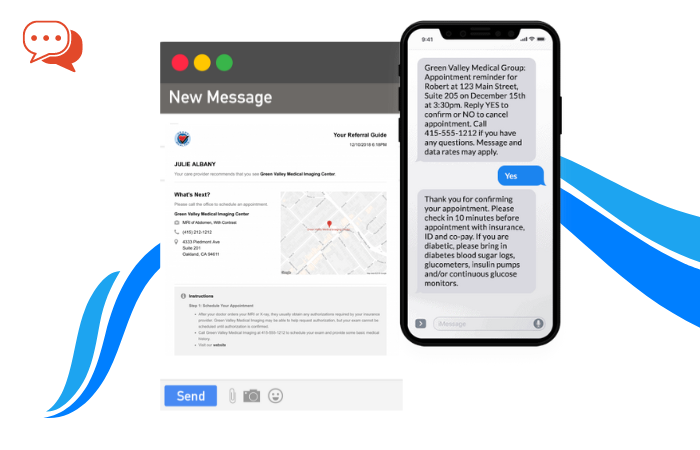The process of managing referrals between healthcare providers can be complex and time-consuming. Inefficient referral management can lead to delayed patient care, increased administrative burden, and decreased overall patient and provider satisfaction. However, modernizing and streamlining referral management processes is now possible with the advancement of technology and the availability of innovative solutions. Patient referrals can lead to faster, better-quality care through improved provider communication and coordination. This blog post will explore six ways your healthcare practice can maximize efficiency and enhance their healthcare practice with effective patient referrals.

1. Implement a Referral Management Solution
One of the most effective ways to modernize referral management processes is by implementing referral management software. This software can digitally capture and track referrals, eliminating the need for manual processes and reducing the risk of errors. It can also provide real-time visibility into the referral status, allowing providers to identify and address bottlenecks or delays. Additionally, referral management software often comes with features like automated appointment scheduling, secure messaging, and analytics, further improving the efficiency and effectiveness of the referral process. Patient referrals play an important role in ensuring continuity of care.
2. Enable Electronic Referral Communication
Traditional referral management often relies on paper-based documents or phone calls, which can be time-consuming and easily lost or misplaced. To modernize the process, healthcare providers should adopt electronic referral communication methods. This can include secure email systems, electronic faxing, or even using a secure online portal for referral communication. Electronic referral communication ensures that information is easily shared, tracks all communication history, and reduces the risk of errors or miscommunication. It also allows for faster and more secure transmission of patient information, ultimately improving patient care.
3. Integrate with Electronic Health Records (EHRs)
Integrating referral management processes with electronic health records (EHRs) is crucial for modernizing the referral process. With seamless integration, providers can easily access patient information and make informed decisions based on the patient’s medical history. Integration with EHRs enables automatic population of referral information, eliminates duplication of data entry, and ensures that all relevant patient data is readily available to both the referring and receiving providers. This integration promotes better care coordination and reduces the administrative burden associated with referral management.
4. Embrace Technology:
Gone are the days of manual referral tracking and paper-based processes. Technology has revolutionized nearly every industry, and healthcare is no exception. By implementing a robust referral management software, you can automate and centralize the entire referral process, from initiation to completion. Such software typically offers automated referral tracking, real-time status updates, and secure messaging capabilities. Streamlining the process reduces administrative burden and improves provider communication and collaboration, resulting in faster and more accurate referrals. Closing the referral loop with the use of technology can prevent the denial of referrals, expedite decision-making, and reduce the risk of malpractice.

5. Utilize Data Analytics:
Data is the backbone of modern healthcare. You can gain valuable insights into your referral management processes by leveraging data analytics. By analyzing referral patterns, you can identify trends, bottlenecks, and areas for improvement.
Data analytics lets you track referral volume, wait times, and patient outcomes. This information lets you make data-driven decisions to optimize your referral management processes. For example, if you notice a provider consistently has longer wait times, you can allocate additional resources or explore alternative referral options.
6. Engage Patients:
Engaging patients in the referral process can profoundly impact their experience and outcomes. Traditional referral processes often leave patients in the dark, with little to no information about their referral status. This lack of transparency can lead to frustration and a breakdown in trust.
Implementing patient engagement tools like patient portals or mobile apps can keep patients informed and engaged throughout the referral journey. Patients can receive real-time updates on their referral status, access educational materials, and even schedule appointments directly. Empowering patients with information enhances their experience and improves adherence to the referral process.
Conclusion:
Modernizing provider referral management processes is one way to improve healthcare efficiency and keep up with the rapidly changing healthcare landscape. By embracing technology, utilizing data analytics, and engaging patients, you can streamline the referral process, improve communication and collaboration, and enhance the overall patient experience. While these changes may require an initial investment of time and resources, the long-term benefits far outweigh the costs.
Providers can streamline the referral process, minimize errors, and enhance patient care by implementing referral management software, such as ReferralMD, enabling electronic referral communication, and integrating with EHRs. Leveraging technology and innovative solutions allows a more efficient and modern approach to managing referrals.
In the ever-evolving world of healthcare, healthcare organizations must constantly adapt and modernize their processes. One area that often gets overlooked is provider referral management. While it may not be the most glamorous aspect of healthcare, an efficient and streamlined referral management process can significantly impact patient care and operational efficiency. Effective patient referrals can drive better outcomes, streamline operations, and deliver more patient-centered care for the benefit of healthcare providers, patients, and the healthcare system as a whole.










